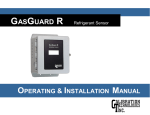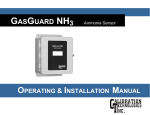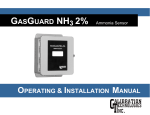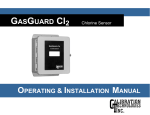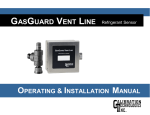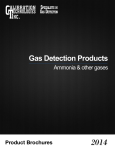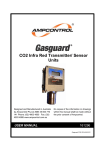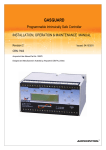Download CTI GG-CO2 User Manual
Transcript
GASGUARD CO2 Carbon Dioxide Sensor OPERATING & INSTALLATION MANUAL GasGuard CO2 Operating and Installation Manual 2 GasGuard CO2 Operating and Instruction Manual Table of Contents General description ………………………………. 4 Installation………………………………….………. 4 Locating the sensor …………………………. 4 Installation guidelines………………………… 5 Wiring………………………………………….. 6 Operation ………………………………………….. 7 Start-up ……………………………...………… 7 Calibration ……………………………….….… 7 Maintenance…………………………….………… 9 Specifications…………………………………….. 10 Warranty………………………………………….. 11 Calibration Technologies 866-394-5861 3 GasGuard CO2 Operating and Installation Manual General Description The GasGuard CO2 sensor is a +24 VDC, three-wire, 4/20 mA sensor for carbon dioxide which utilizes proven infrared sensor technology for accurate and reliable leak detection. The 0-3% (0-30,000ppm) detection range of the GasGuard CO2 provides real-time continuous monitoring of ambient carbon dioxide concentrations. 01% and 0-5% ranges are also available. The GasGuard CO2 provides an industry standard linear 4/20 mA output signal compatible with most gas detection systems and PLCs. The output signal is not affected by drastic temperature and moisture variations that occur during washdown, defrost cycles, etc. The circuit board is forever sealed in potting compound, completely protecting sensitive electronic components and copper tracing from corrosion. The specially vented chemical-resistant polycarbonate enclosure protects the sensor from accidental damage, weather and direct hose-hits from cleaning crews. 4 Installation Locating the sensor One of the most important considerations when installing GasGuard CO2 sensors is that they must be easily accessible for calibration and maintenance. For optimum personnel protection (representative concentration reading that an employee would be exposed to), mount the sensor at a height in the breathing zone of the employees. It would typically be about five feet off the ground, which also allows easy access. As a general rule of thumb, try to mount sensors within 30 feet of potential leak sources. GasGuard CO2 Operating and Instruction Manual Installation Guidelines: • Always mount the sensor vertically. • Must be easily accessible for calibration and maintenance. • Mount the sensor close to the potential leak source. • For optimum personnel protection, mount sensor in the “breathing zone” (4’ – 5’ above floor). • Take air movement and ventilation patterns into account. • To prevent electrical interference, keep sensor and • • • • wire runs away from mercury vapor lights, variable speed drives, and radio repeaters. Protect sensor from physical damage(forklifts, etc.). If mounting sensor outdoors, consider prevailing wind direction and proximity to the most likely source of leaks. Protect the sensor from sun and rain as much as possible. Mount sensor enclosures through the mounting holes as shown in Figure 1. Use the supplied selftapping screws for mounting on sheet metal surfaces. Even though the sensor comes from the factory calibrated, it is always a good idea to calibrate the sensor to the environment in which it is installed. This will compensate for any inaccuracies caused by a change is temperature, altitude, etc. Figure 1: Mounting dimensions 5 GasGuard CO2 Operating and Installation Manual Wiring Electrical wiring must comply with all applicable codes. Electrical Power: 24 VDC regulated, 350 mA. Output: Linear 4/20 mA output. Monitoring equipment may have a maximum input impedance of 700 ohms. Cable Recommendation: 20/3 shielded cable (General Cable C2525A or equivalent). Length of cable to sensor should be no greater than 1,500 feet. Monitoring: Monitoring equipment must be configured to indicate a fault if the signal is below 1 mA. All signals over 20 mA must be considered high gas concentrations. Alarm setpoints should not be lower than 10% of full-scale range. Wiring Guidelines: • Always use three conductor, insulated, stranded, shielded copper cable. • Do not pull sensor wiring with AC power cables. This can cause electrical interference. • If cable runs cannot be made without a splice, all splice connections should be soldered. • Ground the shield at the main control panel. Connect the shield wire in the sensor terminal block labeled SHLD. • Use only the existing conduit hole for connections to the sensor. Figure 2: Wiring diagram 6 GasGuard CO2 Operating and Instruction Manual Operation Start-up Before applying power, make a final check of all wiring for continuity, shorts, grounds, etc. After power-up, allow at least 2 hours for the system to stabilize before testing the sensors. Because sensors are normally located at a distance from the main unit, the test time required and accuracy of the response checks will be improved if two people perform the start-up procedures and use radio contact. Start-Up Test: 1) One person exposes each sensor to calibration gas. (breathing on the sensor can also produce a significant signal rise) 2) The second person stays at the control unit to determine that each sensor, when exposed to carbon dioxide, is connected to the proper input and responds, causing appropriate alarm functions. Calibration The GasGuard CO2 Sensor comes factory calibrated and should require only minimal adjustments after installation. There are two pots on the preamp that are used for calibration. Note: Never measure sensor output in mA. Always use mVDC (or VDC) voltmeter settings. Zero Calibration: After the unit is installed and has been powered up for a minimum of 2 hours, the unit can be zero calibrated by the following: • Apply Zero Air gas (or nitrogen) at 0.8 L/min. • Adjust the zero pot until the sensor outputs 40 mVDC from test points [-] to [+] (see Figure 3). Span Calibration: DO NOT ADJUST THE SPAN POT WITHOUT CERTIFIED CALIBRATION GAS! If span adjustment is required, the following procedure will span the unit: • Perform zero calibration prior to spanning. • Connect tubing to the calibration port of the infrared tube. (see Figure 3) • Apply span gas at 0.8 L/min. • Sensor should react to gas within 10 seconds. • Once the output signal has peaked (or two minutes maximum) adjust the span pot until the correct output is achieved. Note: The adjustment response is dampened. Make slight adjustments (no more than ½ turn of the potentiometer) and wait for output response. If the correct output cannot be achieved, contact Calibration Technologies for technical help. 7 GasGuard CO2 Operating and Installation Manual 8 Figure 3: Sensor output and zero/span adjustments GasGuard CO2 Operating and Instruction Manual Maintenance The GasGuard CO2 was designed for long life and minimal maintenance. For proper operation it is essential that the test and calibration schedule be adhered to. Calibration Technologies recommends the following maintenance schedule Sensor Life: Typical sensor life of the GasGuard CO2 is five to seven years. Failure of the infrared sensor happens normally when the infrared source opens or breaks, similar to an incandescent light bulb filament. If this occurs, the sensor will produce a continuous fault indication signal of 0.5 mA and the fault LED will be lit. Contact Calibration Technologies for a sensor replacement. Maintenance Guidelines: • The sensor is shipped with a factory calibration. Sensor should be calibrated 6 months from purchase date. • Calibrate the detector at least once every 6 months. • Calibration should be performed with certified calibration gas. Calibration kits and replacement cylinders are available from Calibration Technologies. • All tests and calibrations must be logged. 9 GasGuard CO2 Operating and Installation Manual Specifications Detection Principle: Infrared Detection Method: Diffusion Gases: Carbon dioxide (CO2) Ranges: 0-1% (0-10,000ppm) 0-3% (0-30,000ppm) (standard range) 0-5% (0-50,000ppm) Output Signal: Linear 4/20 mA (max input impedance: 700 Ohms) Power Supply: +24 VDC, 350 mA Response Time: T50 = less than 30 seconds T90 = less than 60 seconds Accuracy: +/- 5% of value, but dependent on calibration gas accuracy Zero Drift: Less than 0.5% of full-scale per month, noncumulative Span Drift: Less than 1% per month, non-cumulative Linearity: +/- 0.5% of full-scale Repeatability: +/- 1% of full-scale Wiring Connections: 3 conductor, shielded, stranded, 20 AWG cable (General Cable C2525A or equivalent) up to 1500 ft. 10 Enclosure: Injection-molded NEMA 4X polycarbonate sensor housing. Captive screw in hinged lid. For nonclassified areas Temperature Range: -60°F to +120°F (-51°C to +49°C) Humidity Range: 5% to 100% condensing Dimensions: 7.5” high x 6.5” wide x 3.8” deep Weight: 2 lbs Limited Warranty & Limitation of Liability Calibration Technologies, Inc. (CTI) warrants this product to be free from defects in material and workmanship under normal use and service for a period of one year, beginning on the date of shipment to the buyer. This warranty extends only to the sale of new and unused products to the original buyer. CTI’s warranty obligation is limited, at CTI’s option, to refund of the purchase price, repair, or replacement of a defective product that is returned to a CTI authorized service center within the warranty period. In no event shall CTI’s liability hereunder exceed the purchase price actually paid by the buyer for the Product. This warranty does not include: a) routine replacement of parts due to the normal wear and tear of the product arising from use; b) any product which in CTI’s opinion, has been misused, altered, neglected or damaged by accident or abnormal conditions of operation, handling or use; c) any damage or defects attributable to repair of the product by any person other than an authorized dealer or contractor, or the installation of unapproved parts on the product The obligations set forth in this warranty are conditional on: a) proper storage, installation, calibration, use, maintenance and compliance with the product manual instructions and any other applicable recommendations of CTI; b) the buyer promptly notifying CTI of any defect and, if required, promptly making the product available for correction. No goods shall be returned to CTI until receipt by the buyer of shipping instructions from CTI; and c) the right of CTI to require that the buyer provide proof of purchase such as the original invoice, bill of sale or packing slip to establish that the product is within the warranty period. THE BUYER AGREES THAT THIS WARRANTY IS THE BUYER’S SOLE AND EXCLUSIVE REMEDY AND IS IN LIEU OF ALL OTHER WARRANTIES, EXPRESS OR IMPLIED, INCLUDING BUT NOT LIMITED TO ANY IMPLIED WARRANTY OF MERCHANTABILITY OR FITNESS FOR A PARTICULAR PURPOSE. CTI SHALL NOT BE LIABLE FOR ANY SPECIAL, INDIRECT, INCIDENTAL OR CONSEQUENTIAL DAMAGES OR LOSSES, INCLUDING LOSS OF DATA, WHETHER ARISING FROM BREACH OF WARRANTY OR BASED ON CONTRACT, TORT OR RELIANCE OR ANY OTHER THEORY. 11 GG-CO2 02/2013













